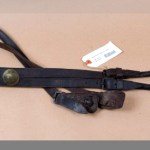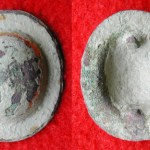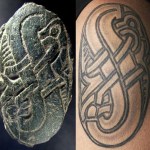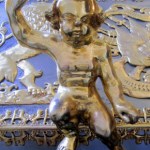metal detecting
From 2014 on, Swedish metal detectorists have had to report all finds datable to before 1850 to the authorities. I have recently shown in a note in Fornvännen that this rule came about by mistake, and that it has broken the County Archaeologist system. It takes hours for a county heritage administrator to process one metal detector permit. It also takes only a few hours for a detectorist to find a copper coin from the 1840s, which voids her/his permit for that site. S/he then applies for a new permit, which means that the pile of unprocessed permit applications on each administrator's…
As I blogged about in late May, a recent find from Blekinge has cast light on an enigmatic oval mount that my team collected in Östergötland in 2007. We can now say fairly confidently that the object type belongs to the 19th century. And yesterday Karin Tetteris of the Swedish Army Museum came through with evidence that strengthens this dating and suggests a function for the mounts: horse harness.
Specifically, we're dealing with cruppers, Sw. svanskappor, "a soft padded loop under the base of the tail, to keep the harness from slipping forward" as Wikipedia explains. None of the mounts in…
In April of 2007 I directed a week of metal detecting at sites in Östergötland where there was a potential for an elite presence in the period AD 400-1000. These investigations were part of a project that I published in my 2011 book Mead-halls of the Eastern Geats.
One site that proved a dud for the project's exact purposes was Tuna in Östra Husby parish. But my friend and long-time collaborator (and these days, colleague) Dr. Tim Schröder found something pretty damn cool anyway: a gold finger ring from AD 310–375, the last phase of the Roman Iron Age. It had been twisted up and thrown into a…
Two strap ends from the eponymous Borre ship grave. Image from Oluf Rygh's 1885 Norske Oldsager.
Metal detectorist Steffen Hansen has kindly given me permission to show you his tattoo sleeve. He found the strap-end at Øvre Eiker in Buskerud fylke, Norway, and had it tattooed along with other Norwegian examples of the Borre style. I haven't got a picture of his find, but you can see what they look like in the accompanying picture of a piece from the eponymous find at Borre in nearby Vestfold fylke. The tattoo was done by Mikael "Kula" Jensen of Radich Tattoo in Mjøndalen.
The Borre style is…
Yesterday I learned about a cool new tradition among metal detectorists. They're having images of their favourite finds tattooed, often on the arm with which they hold the detector! Note that in Scandinavia these are generally objects that the finders have handed in to museums – they keep them only as tattoos. This is in line with the Danish way of regulating metal detectors: there the submitters of each year's ten best finds are invited to the Finds Oscars in Copenhagen and are publicly honoured by my colleagues.
Hugo Falck found this beautiful brooch in 2014 while collaborating with a…
In countries with a big metal detector hobby, the stereotypical participant is an anorak-wearing, rural, poorly educated, underemployed male. I don't know how true this cliché image is. But apart from the anorak, it's certainly an accurate description of the core voter demographic behind the rise of racist right-wing populist parties. These people have trouble finding jobs, and they have trouble seeing through the racist propaganda that tells them they would have jobs and girlfriends if it weren't for the bloody furriners.
I'm known as a detectorist-friendly archaeologist. I've made many…
Fornvännen 2013:2, last summer's issue, is now on-line in its entirety on Open Access.
My friends Mattias Pettersson and Roger Wikell on the Stockholm area's earliest post-glacial settlement site, covered here on Aard during fieldwork in 2010.
Tony Björk and Ylva Wickberg on an early-1st millennium linear monument related to a cemetery and a river ford in Scania.
Svante Fischer et al. on how mid-1st millennium sword fittings were re-used and deposited.
Magnus Green on a 17th century angel on the run from its job as embellishment on a nobleman's sarcophagus.
Olov Gibson on the unresolved…
Most prosperous countries have legislation for what kinds of archaeological finds a citizen has to hand in to the authorities. In Denmark, still using a Medieval term, such finds are termed danefae, "property of the dead". And here is Danish TV4's list of the top-10 such finds of 2012. All but one of them have been handed in by detectorists, and two by Swedish detectorists operating in Denmark because of Sweden's restrictive rules!
It wouldn't really be worthwhile to make a top-10 like this for Sweden, as the pretty gold & silver metalwork they concentrate on in the program is usually…




